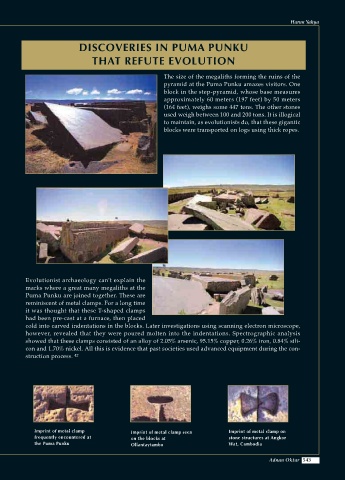Page 545 - Atlas of Creation Volume 2
P. 545
Harun Yahya
DISCOVERIES IN PUMA PUNKU
THAT REFUTE EVOLUTION
The size of the megaliths forming the ruins of the
pyramid at the Puma Punku amazes visitors. One
block in the step-pyramid, whose base measures
approximately 60 meters (197 feet) by 50 meters
(164 feet), weighs some 447 tons. The other stones
used weigh between 100 and 200 tons. It is illogical
to maintain, as evolutionists do, that these gigantic
blocks were transported on logs using thick ropes.
Evolutionist archaeology can't explain the
marks where a great many megaliths at the
Puma Punku are joined together. These are
reminiscent of metal clamps. For a long time
it was thought that these T-shaped clamps
had been pre-cast at a furnace, then placed
cold into carved indentations in the blocks. Later investigations using scanning electron microscope,
however, revealed that they were poured molten into the indentations. Spectrographic analysis
showed that these clamps consisted of an alloy of 2.05% arsenic, 95.15% copper, 0.26% iron, 0.84% sili-
con and 1.70% nickel. All this is evidence that past societies used advanced equipment during the con-
struction process. 42
Imprint of metal clamp Imprint of metal clamp seen Imprint of metal clamp on
frequently encountered at on the blocks at stone structures at Angkor
the Puma Punku Ollantaytambo Wat, Cambodia
Adnan Oktar 543

